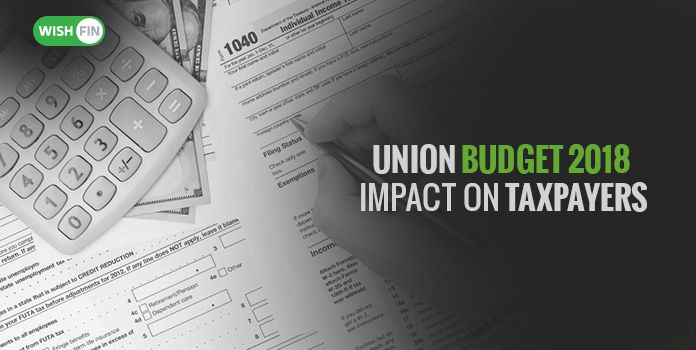What Does the Union Budget 2018 Hold for Taxpayers in India?

Last Updated : Feb. 3, 2018, 3:51 p.m.
After all the wait, the Finance Minister Arun Jaitley finally presented the Union Budget 2018 on the floor of Parliament on February 1, 2018. It was the last full budget of the existing dispensation and so the expectations were very high, particularly on the tax front. Financial experts were expecting a hike in the existing income tax exemption limit of ₹2.5 lakh to ₹3 lakh. On the other hand, speculations of a hike in the existing tax deduction limit of ₹1.5 lakh on investments like Public Provident Fund (PPF), tax-saving fixed deposits and Equity-linked Saving Scheme (ELSS) were also doing the rounds. However, the government did not accept any of these expectations. Instead, it increased the education cess to 4% from the existing rate of 3%. However, the budget proposed a standard deduction of ₹40,000 for both salaried and pensioners.
Standard Deduction Announced in Place of Exemption on Transport Allowance and Medical Reimbursement
Taxpayers were all smiles when Jaitley announced a standard deduction of ₹40,000. But all those smiles vanished when the exemption on transport and medical reimbursement were taken off to accommodate the standard deduction. The maximum tax deduction on transport allowance and medical reimbursement was ₹1,600 per month (₹19,200) and ₹15,000 in a year, respectively. Now, these deductions will be replaced with a flat standard deduction. So, the gains one could have made with the comeback of the standard deduction, which was removed in 2005-2006, were almost neutralized with the removal of exemption on transport allowance and medical reimbursement.
Let’s take the help of an example below to understand the mathematics of tax with respect to these developments better.
Example – Ravi Shukla, a 40-year old software engineer, earns a gross income of₹7 lakh a year. Assume Ravi is provided a transport allowance of ₹19,200 and his medical reimbursement stands at ₹15,000. Let’s check out the tax treatment in both pre- and post-budget scenarios in the table below.
| Particulars | Pre-Budget (In ₹) | Post-Budget (In ₹) |
|---|---|---|
| Annual Income | 7,00,000 | 7,00,000 |
| Standard Deduction | - | (-40,000) |
| Transport Allowance | (-19,200) | |
| Medical Reimbursement | (-15,000) | |
| Taxable Income | 6,65,800 | 6,60,000 |
| Taxes to be Paid Excluding Education Cess | 45,660 (12,500 + 33,160) Upto 2,50,000 - NIL From 2,50,000-5,00,000 @ 5% - 12,500 (5% of 2, 50,000) = 12,500 From 5,00,000-6,65,800 @ 20% (20% of 1,65,800) = 33,160 | 44,500 (12,500 + 32,000) Upto 2,50,000 - NIL From 2,50,000-5,00,000 @ 5% - 12,500 (5% of 2, 50,000) = 12,500 From 5,00,000-6,60,000 @20% (20% of 1,60,000) = 32,000 |
| Education Cess | 4% of 45,660 = 1,826.40 | 4% of 44,500 = 1,780 |
| Total Tax Including Education Cess | 47,486.40 (45,660 + 1,370) | 46,280 (44,500 +1,780) |
So, Ravi’s overall tax liability would reduce to ₹46,280 from ₹47,030 as per the latest budget announcements.
Long-Term Capital Gain Tax Returns After 14 Years
Stock and equity mutual fund investors enjoyed investing for a long period of time as the long-term capital gain was not getting taxed. But will they enjoy with Jaitley’s announcement to tax long-term capital gain exceeding 1 lakh at 10%? Only time will tell. Long-term capital gain, in case of these financial instruments, implies the selling of investments after a year of holding at profit.
Education Cess Hiked to 4%
The government has also announced to hike the existing education cess of 3% to 4%. As per the government, the hike in cess will be used to improve the education and health of families living in rural areas and those who are below poverty line.
